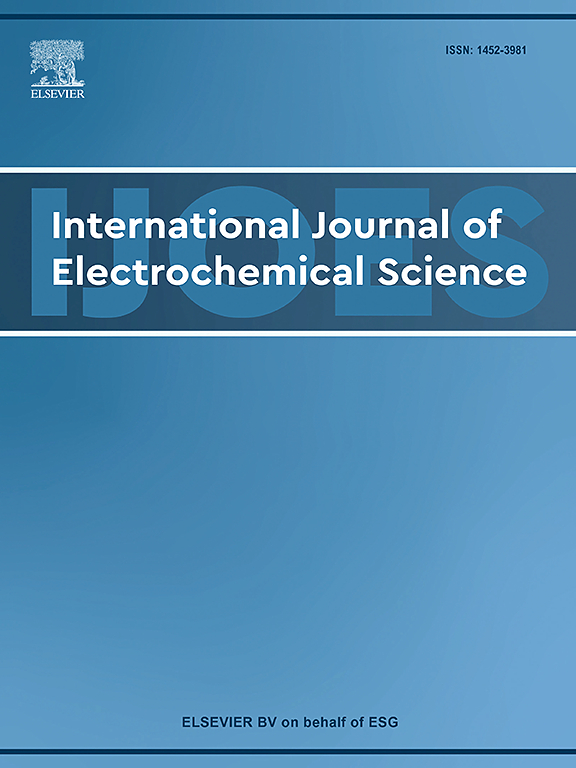7A09铝合金在不同条件下丙二醇冷却液的腐蚀行为
IF 2.4
4区 化学
Q4 ELECTROCHEMISTRY
International Journal of Electrochemical Science
Pub Date : 2025-06-24
DOI:10.1016/j.ijoes.2025.101105
引用次数: 0
摘要
铝合金具有较高的强度和硬度,因此在冷却系统中得到了广泛的应用。然而,长时间使用会导致腐蚀失效。为解决7A09铝合金在丙二醇冷却液中的腐蚀失效问题,系统研究了温度(50 ~ 80℃)、pH值(4 ~ 9)和Cl-浓度(30 ~ 90 mg/L)对铝合金腐蚀行为的协同效应。采用了综合的方法,包括腐蚀测试、电化学极化曲线测量、扫描电镜表面形貌表征和x射线光电子能谱(XPS)表面成分分析。结果表明,温度升高促进丙二醇热氧化,生成有机酸,腐蚀速率呈指数增长(80℃时Icorr达到3040 nA cm−2)。升高的Cl-浓度显著增强了钝化膜点蚀的敏感性,在90 mg/L条件下的腐蚀电流密度比30 mg/L条件下的腐蚀电流密度提高了24.3倍。pH= 4的强酸性环境导致氧化膜的酸性溶解,而在接近中性的条件下(pH= 6-8),铝钝化膜与Al2O3氧化膜协同作用,有效地降低了腐蚀速率。XPS分析进一步证实,Cl-会攻击丙二醇分子中的C-O键,导致C-Cl化合物的形成,从而破坏保护膜的完整性,加速局部点蚀过程。本文章由计算机程序翻译,如有差异,请以英文原文为准。
Corrosion behavior of 7A09 aluminum alloy exposed to propylene glycol coolant at different conditions
Aluminum alloys possess high strength and hardness, making them widely utilized in cooling systems. However, prolonged use can result in corrosion failure. To address the corrosion failure of 7A09 aluminum alloy in propylene glycol coolant, this study systematically investigates the synergistic effects of temperature (50–80 ℃), pH value (4–9), and Cl- concentration (30–90 mg/L) on the corrosion behavior of the aluminum alloy. A comprehensive approach was employed, integrating corrosion testing, electrochemical polarization curve measurements, surface morphology characterization via scanning electron microscopy, and surface composition analysis using X-ray photoelectron spectroscopy (XPS). The results showed that increasing temperature promotes the thermal oxidation of propylene glycol, resulting in the generation of organic acids and an exponential increase in the corrosion rate (Icorr reached 3040 nA cm−2 at 80 ℃). Elevated Cl- concentration significantly enhances the sensitivity of the passivation film pitting, with the corrosion current density rising by 24.3 times under 90 mg/L compared to the 30 mg/L conditions. A strongly acidic environment with pH= 4 induces acidic dissolution of the oxide film, whereas, under near-neutral conditions (pH=6–8), the aluminum passivation film synergizes with the Al2O3 oxide film to effectively reduce the corrosion rate. XPS analysis further confirmed that Cl- attacks the C-O bond in propylene glycol molecules, leading to the formation of C-Cl compounds, which compromises the integrity of the protective film and accelerates localized pitting processes.
求助全文
通过发布文献求助,成功后即可免费获取论文全文。
去求助
来源期刊
CiteScore
3.00
自引率
20.00%
发文量
714
审稿时长
2.6 months
期刊介绍:
International Journal of Electrochemical Science is a peer-reviewed, open access journal that publishes original research articles, short communications as well as review articles in all areas of electrochemistry: Scope - Theoretical and Computational Electrochemistry - Processes on Electrodes - Electroanalytical Chemistry and Sensor Science - Corrosion - Electrochemical Energy Conversion and Storage - Electrochemical Engineering - Coatings - Electrochemical Synthesis - Bioelectrochemistry - Molecular Electrochemistry

 求助内容:
求助内容: 应助结果提醒方式:
应助结果提醒方式:


